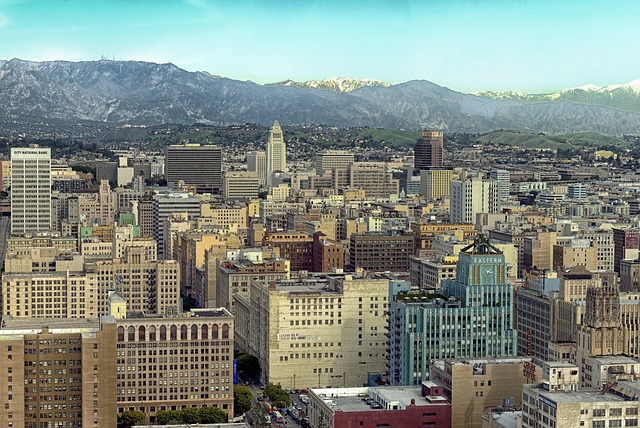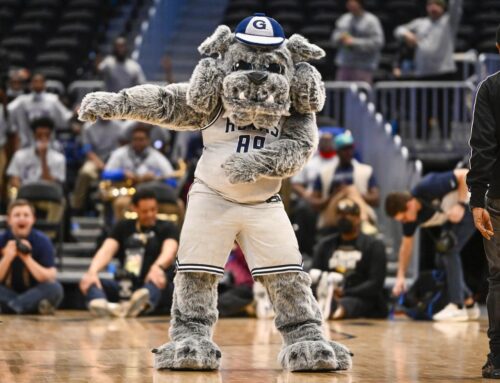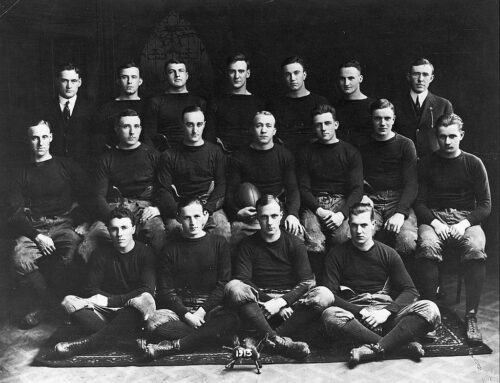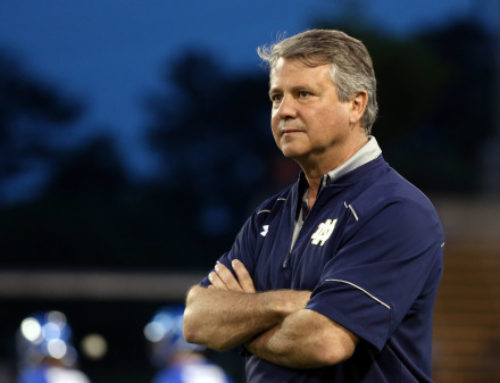We talked about most of the Midwest, the Northeast, and the South already, starting in Indianapolis and working our way around clockwise to Memphis. As we continue with our review of the most notable Notre Dame players from big cities, we’ll polish off the South, move to the Great Plains, and continue through the Southwest and West Coast before ending our journey in the City of Broad Shoulders, which is as it should be given the number of players who have traveled down the Lake Shore Limited to South Bend..
Louisville: None other than the Golden Boy himself, Paul Hornung, takes the honors here; with apologies to two-way Davie-era star Tony Driver, this wasn’t really close. Hornung is the only player ever to win the Heisman for a team with a losing record, which feels like a mixed blessing; much more clearly positive is his pro career, which began with the Packers selecting him #1 overall and saw him record four NFL championships and three scoring titles.
Omaha: Defensive tackle Junior Bryant headed north from the Gateway to the West to suit up for Lou Holtz. Along with future 49ers teammate and Pro Bowler Bryant Young, Bryant terrorized opposing offenses – with the exception of Air Force, who broke Young’s leg with their typical dirty feisty play. But I digress. Bryant’s NFL career was cut short by a neck injury, but in a recurring theme here, he’s doing just fine these days; he’s an executive with a California private equity firm.
Kansas City: Gregarious middle linebacker Lyron Cobbins, who anchored some pretty solid mid-90’s defenses, hailed from the barbecue capital of the world (unless you like vinegar-based sauce, or dry rub, or good God sit down I’m not trying to start a fight here). Cobbs, as he was affectionately known to his fellow Manorites, looked every bit of a D1 linebacker and acted every bit of a friendly, humble guy. He also may or may not have been offered an incentive program involving Ho-Hos after recording his first touchdown in 1995. I wouldn’t know anything about that, if anyone asks.
Dallas: Big D was home to none other than Tim Brown, Notre Dame’s most recent Heisman winner, an All-American, a college and pro football hall of famer, and an all-around good guy. While his raw numbers might not jump off the page when compared to, say, a Corey Coleman, you’d be hard-pressed to find a more dominant receiver who stressed defenses in more ways than Tim Brown did with the Irish.
Houston: Relatively slim pickings in Houston, but safety Gerome Sapp is worthy of mention. As a senior, Sapp teamed with fellow safety Glenn Earl and corners Shane Walton and Vontez Duff to form one of the most dominant – and most surprising – secondaries in Notre Dame history during Ty Willingham’s ersatz “Return to Glory” season in 2002.
San Antonio: Quarterback-turned-receiver Carlyle Holiday no doubt has lunched on the Riverwalk. Or not, I don’t know. Anyway… Holiday moved to receiver in his final season to make room for a sophomore Brady Quinn at quarterback. While he was still helming the offense himself, he initiated perhaps the highlight of the Willingham era – the 65-yard catch-and-run pass to Arnaz Battle that ended in Battle’s phenomenal Tomahawk chop-throat cut gesture. Some flags are worth it…
Las Vegas: Sin City is heavily tilted towards more recent athletes, some of whom are in fact still on the Irish roster. In fact, the choice here is a star who just left the team – Ronnie Stanley, fresh off a redshirt junior season that saw him earn consensus All America honors and a spot as the first offensive lineman off the board in the NFL draft this year, going sixth overall to Baltimore.
Honolulu: We’re going to take a nice little Pacific vacation before returning to the mainland in southern California… Manti Te’o, one of Notre Dame’s most decorated players and a favorite son of Irish fans, played his high school ball in Honolulu. Te’o was the first defensive player in 31 years to win the Maxwell Award, and if the Heisman Foundation followed its stated criteria he would’ve been the first ever full-time defender to win the Heisman. But I digress (again)… Forever remembered outside the Notre Dame fan base for falling victim to a weird catfishing scheme, he’s forever remembered within the fan base for being a great person and one of the most fearsome defenders ever to don the blue and gold. Honorable mention goes to Honoluluan Walter Cabral, who was Notre Dame’s first Hawaiian player, garnering a pair of monograms for his work on the field before heading into a career as an Army officer. The reason he made the list is less for his on-field contributions and more for his fascinating life story, though; in addition to opening the door to the Aloha State for Notre Dame, his story continues to reverberate today for the Irish. His son Jeff coached Manti Te’o in high school. Another son, Brian, played at Colorado and for Mike Ditka and Buddy Ryan in Chicago before moving into a coaching career that brought him back to his alma mater, where we was Teo’s primary recruiter. Brian currently serves as defensive coordinator and associate head coach for former Irish assistant Mike Sanford Sr.’s Indiana State squad. Walter’s daughter Celeste, in her second act as it were, became a Benedictine nun a few years ago after playing basketball for Hawaii and working with Continental as a flight attendant. A nephew, Greg Grohowski, is originally from South Bend and now serves as the executive chef at the Hyatt Regency Maui. Very interesting family.
San Diego: Speaking of that 2002 defense… Captain Shane Walton hailed from sunny San Diego. The converted soccer player was a revelation in 2002, providing the spark and the swagger that Notre Dame had sorely lacked for years.
Los Angeles: Less to choose from here than you’d think, since, like Miami, most of the talent that has gone to Notre Dame has been from the surrounding area rather than from LA proper. Nonetheless, there is another big defensive back name from a southern California metro area here, and it’s Tom Carter. Carter started at safety during the peak of the Lou Holtz tenure before going on to a nine-year NFL career, most notably with the Redskins and Bears.
Fresno: Yes, the Irish did actually get someone from Fresno once… Daryl Lamonica, the Mad Bomber, helmed the Irish offense under Joe Kuharich before going on to a successful pro career. He began in Buffalo as future congressman Jack Kemp’s backup and was traded to Oakland, where he really made his name. He won three AFL championships, two AFL MVPs, and was named to five Pro-Bowl-ish teams (three pre-merger AFL all-star selections and two post-merger NFL Pro Bowl selections).
Seattle: Linebacker Demetrius Dubose was a starter along with Carter during those peak Holtz years. He was drafted in the second round by Tampa but never really caught on in the NFL, and things turned south from there. He ran into financial trouble after some bad investment decisions and ultimately met an untimely death, shot by police officers during a possible burglary attempt. The details are somewhat contested still, but regardless, it was a promising life cut far too short.
Chicago: There’s a reason I started with Indiana and headed east, and it’s actually not my innate East Coast bias – it’s the fact that I wanted to leave Chicago for last. As you might expect, the number of players who have come to Notre Dame from Chicago is staggering – 207 overall out of the 437 “big city” kids pulled together for this research. Nearly half. Picking even just a handful is almost prohibitively difficult, but ultimately I settled on three that at the very least you couldn’t leave off the list. Ed “Moose” Krause went on to become the long-time Notre Dame athletic director, who along with Fr. Ned Joyce played an enormous part in building the university’s athletic programs into what they are today. George Connor was a two-time consensus All-American, a two-time national champion, a member of the college and pro football halls of fame, the winner of the first-ever Outland Trophy, the #5 overall pick in the NFL draft, and a member of the NFL’s 75th anniversary team. Johnny Lattner won the Heisman in 1953, the Maxwell in 1952 and 1953 (he and Tim Tebow are the only two-time winners of the award), and was selected for the Pro Bowl as a return specialist in his lone NFL season after the Steelers drafted him #7 overall. Lattner joined the Air Force after that one year and hurt his knee so badly in a pickup game that his pro career was over, but he had made his mark on the game and the university.





Yep, kinda knew where you were going with Dallas. There’s really no debate there.
Angelo Bertelli from Springfield Mass. Just thought we should mention all the Heisman winners.
As you might expect, the number of players who have come to Notre Dame from Chicago is staggering – 207 overall out of the 437 “big city” kids pulled together for this research.
That’s crazy. I wonder what Chicago looks like over the past 10 to 15 years. Must be a steep, steep decline.